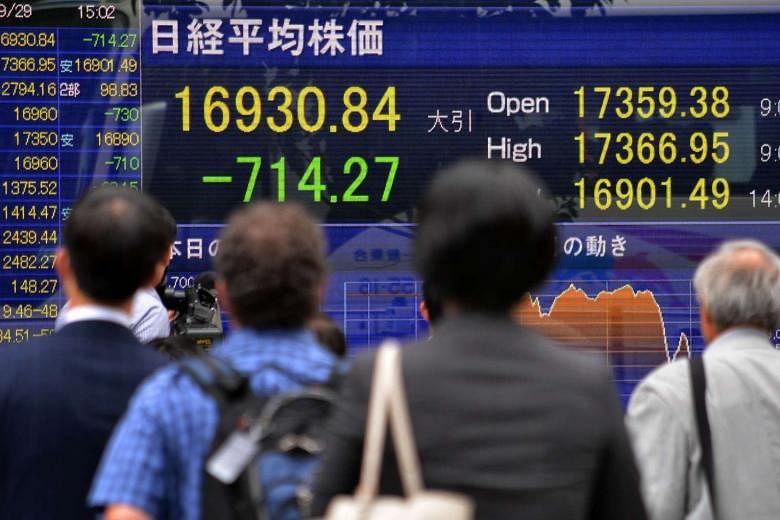HONG KONG (BLOOMBERG) - Asian stocks rose, while Malaysia's ringgit trimmed its biggest three-month loss since 1997, as investors took stock after a quarter of volatile trading that's wiped almost US$11 trillion (S$15.67 trillion) off the value of global shares.
MSCI's Asia Pacific gauge rallied 2 per cent by 1:44 pm in Tokyo, trimming its loss since the end of June to less than 16 per cent, still the most since at least the third quarter of 2011. The last time the measure fell for five straight months was in the period to the end of November 2008, which included the collapse of Lehman Brothers. MSCI's All-Country World Index is down 11 per cent since June 30, its steepest slump since 2011.
In Singapore, the Straits Times Index was trading up 0.14 per cent at 2,791.96 as of 1:34 pm.
The Shanghai Composite Index's 29 per cent drop is the worst performance of any major index globally this quarter. Hong Kong's Hang Seng China Enterprises Index has the second-biggest drop. Investors have fled Chinese equities amid concern that valuations were still too rich and after the shock devaluation of the yuan on Aug 11 added to uncertainty around the strength of the world's No. 2 economy.
The Hong Kong gauge rose 2.5 per cent Wednesday, while its Shanghai Counterpart added 0.7 per cent. The Hang Seng Index advanced 1.4 per cent.
Japan's Topix index jumped 2.8 per cent from its lowest close since January. The measure is headed for its worst monthly loss since May 2012 and its biggest quarterly decline since 2010. Australia's S&P/ASX 200 Index rose 1.3 per cent Wednesday, trimming its quarterly slump to 8.7 per cent.
The Kospi index fluctuated in Seoul as markets in South Korea traded for the first time this week. Taiwan is also back Wednesday after being shut due to a typhoon.
"We expect volatility to remain elevated as Asian policy makers struggle with regional deceleration in growth, and yet more weeks and months of debate over the Fed policy outlook," said Sean Callow, a senior currency strategist in Sydney at Westpac Banking Corp. "It's hard to see how any Asian currency will post sustained, substantial gains in the fourth quarter, with losses versus the US dollar likely to be the norm."
The latest episode of equity selling was spurred by concern that mining and trading companies are being threatened by higher borrowing costs amid a prolonged bear market for commodities. That came amid the collapse in mainland China's equity bubble, selloffs in US technology and biotechnology firms and an exodus from emerging-market assets as the world prepares for the Federal Reserve's first interest-rate increase since 2006. Chinese markets close for a five-day holiday from Thursday, with the US payrolls report due on Friday.
Futures on the Standard & Poor's 500 Index added 0.7 per cent, rising with contracts on the Dow Jones Industrial Average. The US benchmark reversed a drop of as much as 0.5 per cent to end Tuesday up 0.1 per cent amid a rebound in the last 30 minutes.
With risk trades back in play for the last day of the quarter, the Aussie pared its worst quarter since the June 2013, rising 0.3 per cent with New Zealand's dollar. The Aussie has lost more than 9 per cent since the end of June.
The yen was little changed at 119.83 per US dollar after rising 0.7 per cent the past two days. Japan's currency is best performer among major peers the past three months, having added 2.2 per cent; the most since 2012.
"Swings in risk appetite are dominating everything," said Adam Cole, London-based head of global foreign-exchange strategy at Royal Bank of Canada. "Yen has reverted to its traditional status as the markets' choice safe-haven currency."
With Fed officials touting the prospect of a rate increase before the end of 2015, the Bloomberg Dollar Spot Index gained 2.8 per cent this quarter. The gauge, which tracks the greenback against 10 major peers, was little changed Wednesday after falling 0.1 per cent last session.
The Asia Dollar Index, which tracks the region's 10 most- active currencies outside of Japan, has dropped 4.1 per cent this quarter, its worst performance since 2008. Malaysia's ringgit led the rout with a 15 per cent slide as oil prices retreated and Prime Minister Najib Razak was caught up in a corruption investigation. The ringgit halted a seven-day slump, rising 0.1 per cent.
Gold for immediate delivery slipped 0.2 per cent to US$1,125.50 an ounce, its fourth straight drop. The metal is set for a fifth quarterly decline, which would be its worst run since 1997.
The Bloomberg Commodity Index fell 0.1 per cent Wednesday and is down 15 per cent for the quarter. The measure closed at its lowest level since 1999 on Aug. 26.
West Texas Intermediate crude fell 0.8 per cent to US$44.85 a barrel. Oil is set for the lowest quarterly average price since the first three months of 2009 as US industry data showed inventories expanded in the world's biggest consumer and OPEC's second-largest producer increased output.
Copper for three-month delivery on the London Metal Exchange rallied 0.7 per cent Wednesday, paring its loss since the end of June to 13 per cent. The metal is set to cap a fifth straight quarterly decline, having lost 29 percent of its value since mid-2014.

